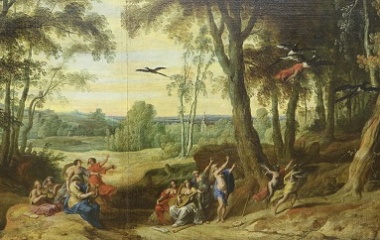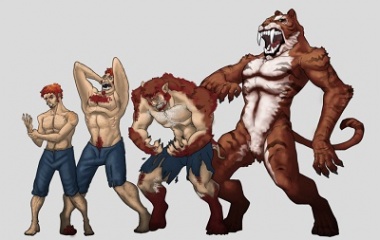What is a Shapeshifter?
Any creature with the ability to undergo a drastic change of appearance is a Shapeshifter. Although they sometimes take monstrous forms, Shapeshifters are not always evil. They can be bloodthirsty, mischievous, helpful, or anything in between.
Characteristics
Physical Description
Naturally, its hard to pin down a Shapeshifter’s appearance. As individuals, their shape is constantly changing, and as a group spread across dozens of cultures, they have a wider variety of shapes than anyone could track.
Beauty is perhaps the biggest trend in their appearance. These characters frequently appear as radiant maidens or strong young men, whose beauty entrances anyone who crosses their path. Other popular forms are wolf-like animals and serpents.
Special Abilities
Shapeshifter’s are as diverse in their abilities as they are in their appearance. Even Shapeshifting, the trait which unifies them, is sometimes more of a curse than an actual magical ability.
In ancient mythology, shapeshifting is just one of the endless magical abilities used by god-like characters. In trickster folklore, shapeshifting is the characters’ only magical ability, but they combines so much cunning with their shapeshifting abilities that they are still a powerful force. In romantic fairytales, shapeshifting is a burden upon powerless characters, who have usually been tricked or cursed by a more powerful magical being.
Shapeshifters Across Culture
Eastern Folklore
Japanese, Chinese, and Korean legends are all crisscrossed with the pawprints of Shapeshifters that transform from foxes into beautiful maidens. These characters are usually evil, using their beauty to seduce and kill men, but occasionally one of the beauties will turn out to be an innocent romantic. Sometimes, Shapeshifters take other forms, such as snakes, cats, badgers, and raccoon dogs.
Indian and Tartar folklore favors Shapeshifters who change from snakes to humans. Again, these characters are almost always up to no good.
Greek and Roman Mythology
Seemingly all of the Greek and Roman gods were Shapeshifters, although some of them enjoyed changing their form more than others. Proteus, a sea god, became famous for his ability to flicker from one form to another to another when enemies pursued him. Zeus, the leader of the gods, used his talent at Shapeshifting for a nefarious purpose; he had a reputation for mistreating beautiful women, so he used Shapeshifting as a way to disguise himself when he approached a new victim.
The gods were also able to transform other people into animals and objects. Often, this sort of transformation was used as a punishment; the goddess Athena transformed a mortal, Arachne, into a spider because she had challenged Athena’s skill at weaving, and Zeus transformed another mortal, Lycaon, into a wolf because he tried to trick Zeus into eating human flesh. Still, in other cases, the gods used their transformative powers to protect or memorialize a mortal. Zeus turned Io, a beautiful nymph, into a heifer, to hide her from his jealous wife, Hera, and Apollo mourned the loss of his lover, Hyacinth, by turning him into a gorgeous flower. Most of these mortals did not become true Shapeshifters after they were transformed by the gods because they weren’t able to change back into a human form again. They were stuck in a non-human form for the rest of time.
Norse Mythology
Like the Greeks, the Norse people attributed the power of shapeshifting to their gods. Loki, the god of chaos and mischief, was particularly fond of shapeshifting and could take any shape that he wanted, even mothering a few monsters while he was in a female shape! Freyja, the goddess of love and fertility, had a cloak of feather falcons which allowed her to transform into a falcon at will. Likewise, Odin was fond of transforming into the shape of an eagle.
Sometimes, mortal Norse people were inspired to attempt shapeshifting as well. Shamans believed that, by entering a ritual state, they could send their spirit out of their body, in the shape of an animal, to roam around the world, while warriors known as “beserkers” believed that they could take the shape of a wolf or bear in battle by wearing the animal’s skin. Mind-altering drugs may have been responsible for convincing both shamans and berserkers that they were, in fact, shapeshifters.
Celtic Folklore
Witches, bards, and sorcerers are responsible for the lion’s share of shapeshifting events in Celtic folklore. Using their gift with magic, these characters could take on almost any form they wanted, and they frequently placed curses on heroes and princesses as well, trapping them in an ugly form until the curse was broken.
In ancient Scotland, two special breeds of Shapeshifter haunted the waters. Selkies, a type of seal that could turn into a human, played in the ocean, while kelpies, a water spirit that could turn into a horse or woman, dwelled in the lakes and rivers. Both of these creatures attempted to lure humans into the water, where they frequently drowned.
Native American Folklore
The Navajo people and many surrounding tribes have a tradition about “skinwalkers,” a group of witches who are able to change into coyotes, wolf, fox, owl, or crow. While the skinwalkers certainly aren’t friendly to humans, they aren’t particularly dangerous either. They enjoy scaring people, but they have never caused anyone physical harm.
Modern Fiction
Shapeshifters have always had a hold on the human imagination, and they continue to figure prominently in our fantasies.
Specific characters can be found shapeshifting their way through some of this century’s most beloved fantasy novels. In JRR Tolkein’s The Hobbit, a character named Beorn turns into a bear; in CS Lewis’ Chronicles of Narnia a character named Eustace Scrubb turns into a dragon; in TH Whites’ The Sword in the Stone both Merlin and the young king Arthur take various animal forms; and in JK Rowling’s Harry Potter series, a group of witches and wizards known as animagi are animal to turn into various animals.
Children’s fairytales, which were first popularized by the Grimm brothers and Hans Christian Anderson and later commercialized by Walt Disney, have also welcomed Shapeshifters into their pages. In many cases, a beautiful prince or princess is trapped in a monstrous form, and their only hope of salvation is to find true love. The hit movies Beauty and the Beast, Swan Princess, and Shrek have all used this theme.
But overall, today’s most well-known Shapeshifter is the werewolf, a man who changes into a wolf, usually under the light of the full moon. This creature inspired a number of early horror films, and today it has claimed a role in popular culture’s more romantic supernatural novels, like Twilight and True Blood.











How to defeat shapeshifter?
How would someone know who is a shapeshifter? And are shapeshifters most commonly considered menaces or helpers? Please answer my questions
In the case of a bird, perhaps a leather hood to becalm him?